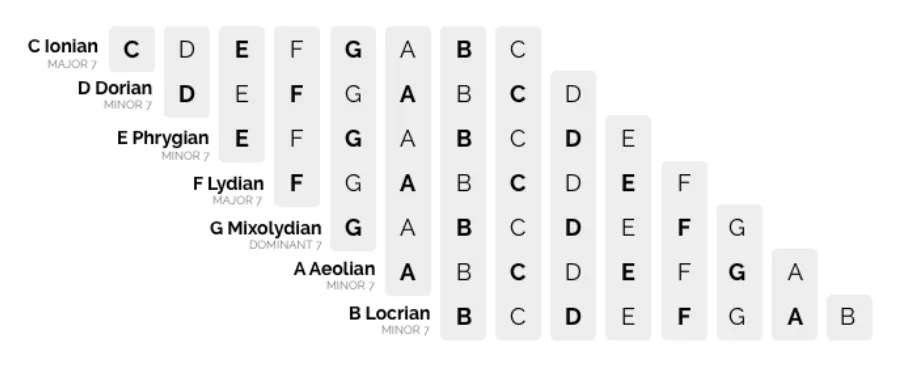When I started my study into jazz harmony I learned just how important the modes of the major scale are. It's a bit of a deep topic, and in this post I'll demystify it for you.
So, what are the 7 modes of the major scale?
| Mode Name | Scale Degree | Example |
|---|---|---|
| Ionian (Major Scale) | I | C-D-E-F-G-A-B-C |
| Dorian | ii | D-E-F-G-A-B-C-D |
| Phrygian | iii | E-F-G-A-B-C-D-E |
| Lydian | IV | F-G-A-B-C-D-E-F |
| Mixolydian | V | G-A-B-C-D-E-F-G |
| Aeolian (Natural Minor) | vi | A-B-C-D-E-F-G-A |
| Locrian | vii | B-C-D-E-F-G-A-B |
In this article I will explore the construction of each of the modes, some popular music examples for each, and ways to apply modal concepts into your jazz playing.
How to construct each mode using the major scale #
You are probably familiar with the Major scale, known more technically as the Ionian mode. There are actually 7 different modes, each which are based off that fundamental major scale. The emotional quality of the music we are playing is largely based on its mode.
The formula for the modes are the same in every key. Since there are 12 keys, there are 12 different sets of these modes. Each set is based on the root pitch in the key.
Let's work in the key of C and learn how to build each of the modes in that key. Start by writing down the C major scale.


Step-by-Step Video Training
As a premium member of Jazz-Library you will have access to our Jazz Fundamentals video course which has 70+ video lessons teaching you these scales, modes, chord voicings, soloing strategies and more.
The major scale starts on its root C and ends on the C an octave higher. That scale can be repeated endlessly up and down, at least within the range your instrument can play.
Although the major scale is typically played from root to root, it technically has no boundaries. You could play the same notes of the scale starting and ending on G, A, E or any other of its notes instead.
As such, one major scale can actually create 7 different scales with the same notes. Those scales are called modes, and each of them has a unique name and sound.
Look at this chart to see what I mean. All modes in the key of C contain the same 7 notes, in the same order. They just start on different pitches.

Breaking down each of the modes independently. #
Let’s break down each of the modes individually. For each of them listed below, I’ll identifying their notes, chord tonality, and list a few example songs you may know in that mode.
For the following section I’ve broken away from thinking about all white notes. Instead, I’ve opted to keep the root of C the same throughout. I encourage you to play through each of the modes on your instrument, and listen to the emotional differences between them. I find that easier to comprehend if you keep the root the same.
Ionian Mode #
Perhaps the most famous of all the modes, Ionian, is also known as the Major Scale. It’s bright, sunny and familiar sounding. It’s the scale Maria made famous in The Sound of Music ... “Doe, a deer...”

- Scale (
CIonian):- C - D - E - F - G - A - B - C
- Chord Tonality: Major 7th Chord
- Examples
- Let it Be - Beatles
- Brown Eyed Girl - Van Morrison
- Ode to Joy - Symphony #9 - Beethoven
Dorian Mode #
The dorian mode is characterized by a flat-3 and flat-7. It’s a brighter sounding minor tonality, compared to the common relative minor Aeolian mode.

- Scale (
CDorian):- C - D - Eb - F - G - A - Bb - C
- Chord Tonality: Minor 7th Chord
- Examples
- A Horse with No Name - America
- Eleanor Rigby - Beatles
- Riders on the Storm - The Doors
Phrygian Mode #
The phrygian mode has a flat-2, flat-3, flat-6 and flat-7. It has a bit of a middle-eastern or Egyptian flair to my ear.

- Scale (
CPhrygian):- C - Db- Eb - F - G - Ab - Bb - C
- Chord Tonality: Minor 7th Chord
- Examples
- White Rabbit - Jefferson Airplane
- Space Oddity - David Bowie (intro only)
Lydian Mode #
Lydian, with it’s sharp-4, is one of my favorites to play. It’s dreamy feeling and the resolution to the major I chord is gentle, almost as if it’s affected by less gravity.

- Scale (
CLydian):- C - D - E - F# - G - A - B - C
- Chord Tonality: Major 7th Chord
- Examples
- Theme from The Simpsons
- Theme from The Jetsons
- E.T. Flying Theme - John Williams
Mixolydian Mode #
The Mixolydian mode is a favorite of blues artists. It’s flat-7th scale degree makes the resolution always feel a bit unsettled.

- Scale (
CMixolydian):- C - D - E - F - G - A - Bb - C
- Chord Tonality: Dominant 7th Chord
- Examples
- Norwegian Wood - Beatles
- Sweet Child O’ Mine - Guns ’n Roses
Aeolian Mode #
In school I was taught Aeolian as the “relative minor” key. It’s the traditional minor key used in classical music, and has a sad, depressing and sometimes angry quality.
It’s notes are the same as the Natural Minor Scale, with a flat-3, flat-6 and flat-7.

- Scale (
CAeolian):- C - D - Eb - F - G - Ab - Bb - C
- Chord Tonality: Minor 7th Chord
- Examples
- Losing My Religion - R.E.M.
- You Give Love a Bad Name - Bon Jovi
- All Along the Watchtower - Jimi Hendrix
Locrian Mode #
The Locrian is used in fleeting angry or evil sounding moments. It’s deeply unsettling and unstable, and the root has no feeling of “home.”
It does give a unique dissonant quality that is useful in solo passages, but I’ve never found a song written with Locrian as it’s primary mode.
It contains the flat-2, flat-3, flat-5, flat-6 and flat-7, and has a most unsettling half-diminished chord as it’s tonic.

- Scale (
CLocrian):- C - Db - Eb - F - Gb - Ab - Bb - C
- Chord Tonality: Half-Diminished Chord
Constructing jazz chords using each modes of the major scale #
To build a chord, select your mode and identify the relevant root note. Starting from that root, move up the scale, selecting every other note on the way until you have 4 notes. I’ve bolded them in the diagram at the top of this post.
Note: traditional classical music only uses 3 note chords.
In Ionian mode, the root chord is constructed as follows. In this case, it produces a C major seventh chord.

Following the same pattern, you can build an D minor seventh chord as the root of the D Dorian mode.

You can continue this pattern for each of the 7 modes.
Notice that these chords come in different qualities — major, minor, dominant or half-diminished based on the intervals of the specific mode you select as the basis:
| Mode Name | Scale Degree | Chord Quality |
|---|---|---|
| Ionian (Major Scale) | I | Major 7 |
| Dorian | ii | Minor 7 |
| Phrygian | iii | Minor 7 |
| Lydian | IV | Major 7 |
| Mixolydian | V | Dominant 7 |
| Aeolian (Natural Minor) | vi | Minor 7 |
| Locrian | vii | Half-Diminished 7 |
For each mode, the V chord is always dominant #
Okay, "always" may be too strong of a word here. But, practically speaking, when playing in any mode, the V chord is almost always played as a dominant 7.
This is because the function of a dominant chord resolving down a fifth (from V to I) is so important to establishing the root as "home" in the key.
Because of this, most players consider the dominant chord to be "in the key" even if it technically is not. In all modes except Ionian, the V chord uses notes outside of the key to make the dominant chord quality.
For example, in D Dorian the V chord should technically be Amin7 (A-C-E-G), but we would alter that to be A7 (A-C#-E-G).
Building 2-5-1 Progression in each Mode #
The 2-5-1 progression is the most fundamental and important chord progression in jazz. Knowing your 2-5-1 progressions in all major keys (Ionian Mode) is a bedrock foundation for any jazz musician.
By building that 2-5-1 progression in C Ionian mode, you start by building a chord with the 2nd note of the scale, D, as the root. You then repeat that for the chord on the 5th note, and then on the 1st note. By doing so, you use all 7 notes of the scale in a way the drives you back home to the tonic chord.
This creates the following 2-5-1 progression: ii min - V dominant - I major, or simply: ii-V-I.

In addition to mastering these major (Ionian) ii-V-I progressions in all keys, jazz musicians will also learn the minor variation, which is built on the Aeolian mode: ii minor 7 flat 5 - V dominant - i minor, or: ii7b5-V7-i.
Here’s how that looks in A Aeolian mode:

Note the use of the substitute dominant V chord, E7, per the explanation in the previous section.
Knowing both your major ii-V-I and your minor ii7b5-V-i will make playing through most jazz standards a breeze. In fact, it’s rare to see musicians spend time expanding beyond those. But, if you aspire to join the ranks of Herbie Hancock, Chick Corea or Jacob Collier, you may enjoy building 2-5-1’s in each of the 7 modes.
If all 7 modes use the same notes, why not just think “play C Major?” #
So, if the notes are the same between all 7 modes, which means the chords are the same, why not just think “C Major” all the time?
The truth is (and don’t tell my snobby jazz friends) a lot of the time you can. While its most important to recognize the main tonality of the song, C major vs. the relative A minor you can do quite well improvising by simply thinking “all white notes”... aka, C.
But, there are a few reasons you should think about modes instead.
Recognizing the root note in the mode you are playing #
When playing in any mode -- even if you are just thinking “play C major” you must remember where “home” is and improvise lines that journey from home, and bring you back again.
For that reason, it’s vital to understand the overall tonality of the song you are playing. If you are playing a minor song in D Dorian, you should aim to base your resolutions around a root of D minor.
This means recognizing when it's time to use the substitute dominant chord for the V, as explained previously.
Each mode has unique “avoid notes” #
Perhaps the biggest problem with thinking “play C major” is "avoid notes." These are notes in the scale that clash with the chord you are currently playing. If you just think “play C major” all the time it’s easy to create harsh sounding lines with unpleasant dissonance.
Each chord of your tune has “avoid notes” within its mode. As you play, you need to be conscious of those notes so you can... well... avoid them.
I've written a whole article about these avoid notes.
Each mode evokes its own mood, or emotion. #
The last reason to avoid thinking “play C Major” is because you may have intentionally chosen a mode based on the mood it evokes.
For example, the Lydian mode has a dreamy, floating quality to it, which is uplifting and rejuvenating. As such, it was the mode John Williams chose for the famous Flying theme in E.T.
Relationship to the Circle of Fifths #
Lastly, because jazz music often changes it’s tonality throughout the piece, switching key centers as the chords progress, you often shift between modes as well. (Especially in a sub-genre of jazz called... wait for it... “modal jazz.”)
Much like chords move around the circle of fifths, feeling brighter when you move clockwise, and darker counter-clockwise, modes work the same way.
To demonstrate this, by arranging the modes in order of the circle of fifths, you’ll see that at each step another flattened-note is added to the scale:
- Lydian
- Ionian
- Mixolydian
- Dorian
- Aeolian
- Phrygian
- Locrian
